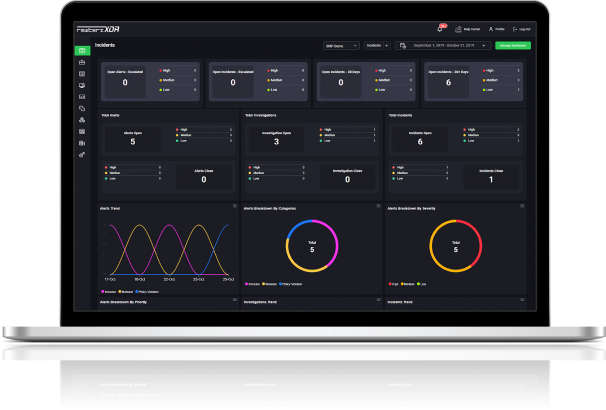

SideWinder APT Group aka Rattlesnake – Active IOCs
August 7, 2025
Windows UAC Bypassed via Character Map
August 8, 2025
SideWinder APT Group aka Rattlesnake – Active IOCs
August 7, 2025
Windows UAC Bypassed via Character Map
August 8, 2025It’s clear that cyber threats affect businesses in every industry. As malicious attacks evolve at breakneck speed, they challenge organizations to manage increasingly sophisticated attack vectors. Traditional security methods, while still popular, struggle to respond effectively to the scale and complexity of modern cyber threats. This is an opportunity for security teams to lean heavily on Artificial Intelligence (AI). As the next frontier of cyber security, AI-driven automated incident response is transforming cybersecurity by accelerating threat detection, analysis, and remediation.
In this blog, we will take a closer look at Automated Incident Response; defining what it is and how it can benefit organizations. We then explore how AI is redefining incident response strategies, the rapid advancements in AI for cybersecurity, and how organizations can maximize their security posture through AI-powered solutions.
What is Automated Incident Response?
Automated incident response is a cyber security feature that leverages artificial intelligence, machine learning, and automated workflows to detect, analyse, and remediate security threats. This is advantageous to organizations as it minimizes the need for extensive human involvement. Traditional incident response methods can rely on manual processes, which can be slow and ineffective when dealing with large-scale or complex attacks. In contrast, automated incident response enables real-time threat identification and mitigation, reducing the window of opportunity for attackers to exploit vulnerabilities.
By leveraging AI-driven security tools, automated incident response can quickly assess incoming threats, correlate security events across multiple systems, and determine the best course of action to neutralize an attack. Automated playbooks and security orchestration platforms streamline the response process, ensuring consistency and efficiency while minimizing human error. This approach significantly boosts an organization’s cybersecurity resilience by enabling faster decision-making and proactive threat containment.
The Integration of AI into Incident Response Strategies
Incident response is a crucial element of cybersecurity, ensuring that threats are identified, analysed, and mitigated before they can cause significant damage. AI and machine learning (ML) are playing a pivotal role in enhancing incident response strategies. Here are some of the ways that they contribute:
- Real-Time Threat Detection: AI-driven security solutions analyse massive volumes of data to detect anomalies and potential threats in real time. Unlike traditional rule-based systems, AI can identify previously unseen attack patterns, making it singularly effective against zero-day threats.
- Automated Analysis: Machine learning models enhance forensic capabilities by swiftly analysing incident data, correlating events, and identifying root causes. This speeds up the decision-making process for security teams and reduces false positives.
- Intelligent Threat Hunting: AI-powered threat hunting automates the detection of malicious activities, enabling security teams to proactively search for indicators of compromise (IoCs) and react before attackers can inflict damage.
- Adaptive Learning: AI continuously improves by learning from past incidents, refining its detection models to identify evolving threats more accurately.
The Growing Need for AI in Cloud Security
Businesses are undergoing digital transformations to keep up pace with the requirements of modern customers. With the shift to cloud environments, traditional security measures have struggled to keep pace with the dynamic and distributed nature of cloud infrastructures. The horizontal spread of services and tools increases attack vectors that tantalize hackers. AI-driven security solutions address these challenges by:
- Monitoring Multi-Cloud Environments: AI continuously analyses security data from multiple cloud platforms, providing comprehensive visibility into potential threats.
- Behavioural Analytics: AI identifies deviations in user and entity behaviour (UEBA) to detect insider threats and account takeovers.
- Automated Response in the Cloud: AI-driven orchestration and response mechanisms help mitigate threats by automatically isolating compromised assets, applying security patches, or enforcing access controls.
The Challenge of Traditional Security Methods
Traditional security models rely heavily on manual intervention and predefined rules. This fundamental trait makes them a weak challenge to modern cyber threats. The essential limitations of traditional security methods include:
- Volume and Complexity of Threats: Organizations receive thousands of security alerts daily, leading to alert fatigue and missed critical threats.
- Slow Response Times: Manual incident response can take hours or days, allowing attackers ample time to exploit vulnerabilities. This costs businesses revenue and loss of reputation that can be difficult to recover.
- Lack of Contextual Awareness: Rule-based systems often fail to differentiate between normal and malicious activities due to their static nature.
How AI Bridges the Security Gap
AI enhances cybersecurity defences by tackling the failings of traditional security methods. Organizations will enjoy its benefits that can involve:
- Accelerating Incident Detection and Response: AI-powered security systems process and analyse vast amounts of data in real-time, allowing for near-instantaneous threat detection and response.
- Reducing False Positives: Machine learning models refine detection algorithms, minimizing false alarms and helping security teams focus on genuine threats.
- Threat Intelligence Integration: AI aggregates threat intelligence from various sources to provide contextual insights and improve decision-making.
- Automated Mitigation: AI-driven security tools can autonomously contain threats by isolating affected systems, revoking user access, or deploying patches. These strategic interventions ensure swift containment without majorly disturbing regular business practices.
Best Practices for Leveraging AI in Cybersecurity
To maximize the benefits of AI in cybersecurity, organizations should adopt the following best practices:
- Invest in AI-Powered Security Platforms: Deploy AI-driven SIEM (Security Information and Event Management) and SOAR (Security Orchestration, Automation, and Response) solutions to automate incident response workflows.
- Enhance Threat Intelligence Capabilities: Leverage AI-based threat intelligence to gain deeper insights into emerging cyber threats and improve proactive defence measures.
- Implement Continuous Monitoring and Adaptive Security: Utilize AI-driven analytics to detect deviations in user behaviour and network traffic in real time.
- Integrate AI with Human Expertise: AI should augment, not replace, human analysts. Security teams should be trained to interpret AI-generated insights and take appropriate actions.
- Regularly Update AI Models: AI-driven security solutions must be continuously trained on the latest threat data to ensure optimal performance.
Artificial Intelligence is revolutionizing incident response by improving the speed and accuracy of threat detection, analysis, and remediation. As cyber threats become more complex, AI-powered security solutions provide organizations with the necessary tools to detect and respond to threats in real-time, particularly in cloud environments. By integrating AI into their cybersecurity strategy, organizations can bridge the gap left by traditional security methods and strengthen their defence against cyber threats by enhancing human expertise, analysing data in record times, and monitor the breadth of evolving cyber attacks around the clock.
At Rewterz, our cybersecurity experts specialize in automated incident response, leveraging AI to enhance security resilience. Whether you are actively looking to uplevel your organization’s cybersecurity capabilities, or just curious about how Automated Incident Response can protect your company, contact Rewterz today and discover how our expertise in AI-driven security can safeguard your digital assets.








